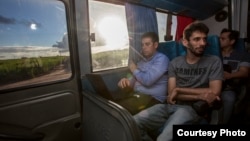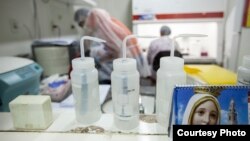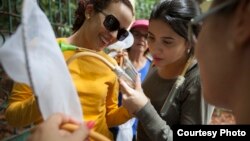An international team of researchers is using mobile genetic technology on the ground in Brazil to combat the Zika virus.
The team, with a state-of-the-art DNA sequencer, and two vans, is analyzing up to 750 blood samples along a coastal stretch of northeastern Brazil. The region has been hardest hit by the virus, which causes birth defects.
Babies with microcephaly have been born to mothers infected with Zika. They have unusually small heads and brains, a condition that can lead to intellectual disabilities, movement problems and seizures.
The virus is also thought to be responsible for the paralytic illness Guillian-Barre syndrome.
Researchers are looking for viral signature of infection and mutations to try to track the spread of Zika, according to Nick Loman of the Institute of Microbiology and Infection at the University of Birmingham in England.
Loman, who is leading the mobile Zika surveillance project, ZIBRA, said scientists are hoping to construct a map see where the virus has come from and where it may be headed, from population dense regions to small towns.
“Getting genome sequence information is really one of the nicest ways of getting an unbiased view of what the pathogen is doing, how it’s moving around populations, how many times it’s moving from one place to another,” Loman said.
The data from the sequencing project will be made freely available to any researchers or public health analysts investigating the spread of Zika.
Lessons from Ebola
Loman said Zika was first identified in Uganda in the late 1940s and it eventually spread to Asia. He says microcephaly was not a feature of those earlier cases, so the virus has picked up mutations along the way that contribute to the birth defect.
Loman hopes better understanding the relationship between Zika and microcephaly will speed development of treatments and vaccines.
The lightweight DNA sequencer researchers are using in their road study weighs less than 100 grams and is powered by a laptop.
The equipment was first used by the investigators in Guinea to analyze Ebola in blood samples in the West Africa country. Scientists were able to learn almost immediately how Ebola cases were related during the epidemic.
That information aided World Health Organization epidemiologists and others to contain the deadly virus.
Comparing new Zika strains with older ones in Brazil will hopefully offer up clues to how the virus is now behaving, according to Loman.
“We really want to get a good view of how Zika looked in 2015 and how it’s looking this year in order to compare and to see how the virus has evolved and how it’s mutated, and see whether those mutations give us an idea about how quickly it’s spreading around Brazil, and try to make predictions about what it might do next,” Loman said.
That information is extremely important in light of the looming Summer Olympics Games in Rio de Janeiro.
Loman is hoping the genetic analysis of Zika can be used to lessen the threat of Zika infection to attendees to the international sporting event hosted by Brazil.
The Zika project is a joint venture of the University of Birmingham, the Brazilian Ministry of Health, the University of Sao Paulo and the Fundacao Oswaldo Cruz. The team also includes researchers from Australia and Canada.










